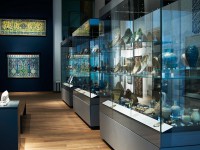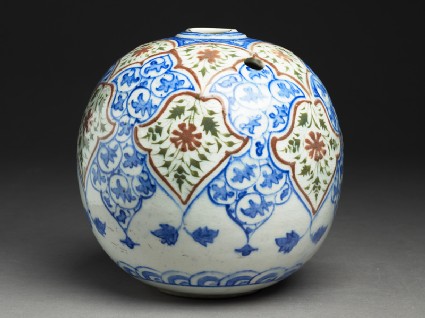Room 31 | Islamic Middle East gallery
Explore artefacts made over a period of more than 1000 years in the heart of the Islamic world.

Galleries : 258 objects
- Reference URL
Actions
Base of a water pipe with floral decoration
-
Details
- Associated place
- Date
-
17th century (1601 - 1700)
Safavid Period (1501 - 1722)
- Material and technique
- fritware, with underglaze painting in coloured slips and blue
- Dimensions
-
17.8 cm (height)
18 cm (diameter)
at foot 7.5 cm (diameter)
- Material index
- Technique index
- Object type index
- No. of items
- 1
- Credit line
- Gift of Gerald Reitlinger, 1978.
- Accession no.
- EA1978.1712
-
Further reading
Allan, James W., Islamic Ceramics, Ashmolean-Christie's Handbooks (Oxford: Ashmolean Museum, 1991), no. 39 on p. 62, illus. p. 63
Glossary (2)
fritware, underglaze painting
-
fritware
Ceramic material composed of ground quartz and small quantities of clay and finely ground frit (frit is obtained by pouring molten glass into water).
-
underglaze painting
Painting applied to ceramic material before a transparent, or monochrome or coloured glaze for Islamic objects, is applied. The technique was initially developed in China.
Location
Objects are sometimes moved to a different location. Our object location data is usually updated on a monthly basis. Contact the Jameel Study Centre if you are planning to visit the museum to see a particular object on display, or would like to arrange an appointment to see an object in our reserve collections.
Galleries
Collection trails
Publications online
-

Islamic Ceramics
Tobacco was introduced into the Islamic world by Europeans, who had themselves first encountered it in the Americas. The method adopted for smoking tobacco in the Near East was, however, different from that adopted in Europe, for the Persian kalian (in the Arab world a hookah and in India a narghile) is a type of pipe which uses a metal or ceramic vase containing water. The tobacco is burnt in a holder above the vase, and the smoke is drawn downwards through the water by sucking a hollow rod or tube attached to the shoulder of the vase. Rosewater is often used in the vase to sweeten the flavour.
The two commonest forms in Persian soft-paste porcelain are the sphere and the pear-shaped bottle. The pear-shaped kalian illustrated [EA1978.1703] is decorated with rocks, pines and waterfalls in the Transitional Ming style of 1620 – 1683. Very little Chinese porcelain was exported at this period and Persian copies are very rare. The spherical kalian [EA1978.1712] is an example of the polychrome soft-paste porcelains probably made in Kirman at this period. Late seventeenth century travellers, and the records of the Dutch and British East India Companies, all affirm Kirman as the producer of the finest ceramics of the day: its geographical location in central southern Iran meant that it was well placed for export to Bandar Abbas, a port at the eastern end of the coast of the Persian Gulf, and the Indian Ocean. The finely painted leaves and flowers in orange-red and olive-green suggest an origin in book illumination (cf. no. 34-35 [EAX.3080 & EAX.1207]), while the leaves and stems in underglaze blue are in a very decadent and totally contrasting style.
Notice
Objects may have since been removed or replaced from a gallery. Click into an individual object record to confirm whether or not an object is currently on display. Our object location data is usually updated on a monthly basis, so contact the Jameel Study Centre if you are planning to visit the museum to see a particular Eastern Art object.
© 2013 University of Oxford - Ashmolean Museum












